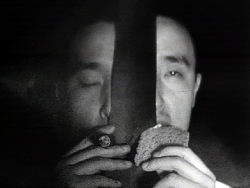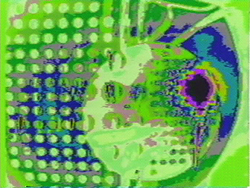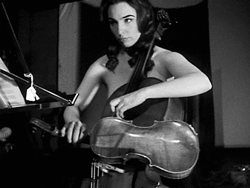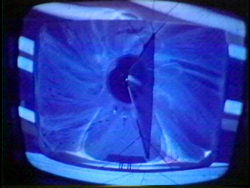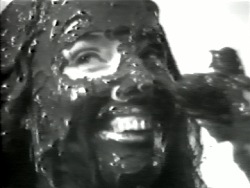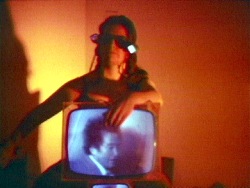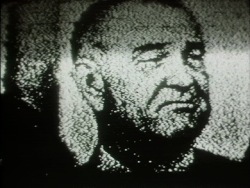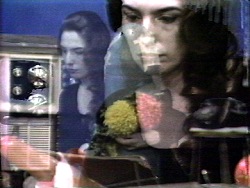
JUD YALKUT
Daylong Tribute Screening at EAI
JUD YALKUT
Daylong Tribute Screening at EAI
535 West 22nd Street, 5th floor New York, NY 10011
JUD YALKUT
Daylong Tribute Screening at EAI
535 West 22nd Street, 5th floor New York, NY 10011
JUD YALKUT
Daylong Tribute Screening at EAI
535 West 22nd Street, 5th floor New York, NY 10011
Works
This tape is Jud Yalkut's video realization of Charlotte Moorman and Nam June Paik's concert performance of John Cage's composition 26'1.1499" For String Player. In this extraordinary performance, which is manipulated and synthesized by Yalkut, Paik and Moorman play Cage's score on a collection of "instruments" that include a pistol, a dish of mushrooms, balloons, a practice aerial bomb, and a telephone call to President Nixon.
Founded and directed by Charlotte Moorman, the Avant Garde Festivals began in 1963 and featured experimental music, art, and performances in diverse sites around New York. Yalkut's rare historical documents record the 4th and 7th events. Held in Central Park in 1966, the 4th Festival included Allan Kaprow, Al Hansen, Christo, Shigeko Kubota, and Joseph Beuys, among others. The 7th Festival was held in 1969 on two islands in the East River. Yalkut documents performances on Wards Island, beneath one of Buckminster Fuller's geodesic domes.
Cinéma Metaphysique: Nos. 2, 3 and 4
Nam June Paik and Jud Yalkut
1967-72, 8:39 min, b&w, sound, 16 mm film on video
This early work belongs in the company of Paik and Yalkut's classic collaborative "video-films." To the accompaniment of the abrupt sonic interjections of Fluxus-affiliated composer Takehisa Kosugi, Yalkut's film records brief, masked views of human actions. Reminiscent of Beckett's theater, as well as the minimal movements of 1960s avant-garde dance, Cinéma Metaphysique is a study in gesture and stillness, noise and silence.
Film Video Works #3
Nam June Paik and Jud Yalkut
1966-69, 7 min, b&w and color, sound, 16 mm film on video
These two historical collaborations between Nam June Paik and Yalkut reveal some of Paik's earliest experiments with television and electronic imagery. In Missa of Zen, a TV screen, filmed from an extremely oblique angle, appears as a ghostly, flickering sliver at the side of a darkened frame. In Electronic Moon, colorized images of the moon are accompanied by Glenn Miller's Moonlight Serenade.
Yalkut creates a poetic homage to Lazlo Moholy-Nagy's pioneering 1930 kinetic sculpture Light-Space Modulator, which was reconstructed at the Howard Wise Gallery, New York, in 1970. Yalkut's silent Light Display: Color combines processed analogue and digital imagery derived from the original 16mm film that he shot at the gallery.
Yalkut's film is the only record of Nam June Paik's legendary 1967 performance Opera Sextronique in New York, which was interrupted by the arrest of cellist Charlotte Moorman, who was performing topless. The incident led to Moorman's subsequent notoriety as the "Topless Cellist." This studio restaging of Opera Sextronique, performed by Moorman and filmed by Yalkut, was shot immediately after the arrest incident to present at Moorman's trial. (The judge did not permit it to be shown in court.)
Some Manipulations depicts a series of 1969 performances at the Judson Church by Fluxus artists Jean Toche, Steve Young, Nam June Paik, and Al Hansen. Yalkut creates a staccato mix of color, motion and shape.
In 1969, Howard Wise presented the landmark exhibition TV as a Creative Medium at his eponymous gallery on 57th Street in New York. The exhibition is recognized as the first in the United States devoted to video (or television) as an emergent art form. Jud Yalkut's silent 16mm film footage is a...
Yalkut documents the "chocolating" of Charlotte Moorman at the Clocktower in New York City on Easter Sunday, 1973. This project was based on a concept by artist Jim McWilliams, who devised other performance events for Moorman, including the Flying Cello.
This portrait of Nam June Paik was produced as a "video catalogue" for the national touring exhibition The Electronic Super Highway, which premiered at The Museum of Art in Fort Lauderdale, Florida. This work features recent installations, historical background and interviews with the artist....
Video Synthesizer and "TV Cello" Collectibles
Jud Yalkut and Nam June Paik
1965-71, 23:25 min, color, silent, 16 mm film on video
This restored collection of rare early collaborative works by Nam June Paik and Jud Yalkut is historically significant as well as remarkably prescient. Recorded between 1965 and 1971, these "video-films" reveal insights into the evolution of Paik's work in video, performance and installation, and...
Video-Film Concert
Nam June Paik and Jud Yalkut
1966-72, 1992, 34:50 min, b&w and color, sound, 16 mm film on video
This restored collection of rare early collaborative works by Nam June Paik and Jud Yalkut is historically significant as well as remarkably prescient. Recorded between 1967 and 1972, these playful and improvisational "video-films" reveal insights into the evolution of Paik's work in video, performance and installation.


